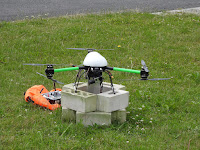Yesterday evening we met the other teams from all over Europe for the first time during the opening ceremony and the social dinner. Afterwards, we finished our work on the parachute and created the 5 minute-presentation for today.
Today we drove at 8:00 am to the airfield Rotenburg Wümme for the technical inspection of the CanSats, the drop test, and the short presentation.
 |
| view of the runway |
After we held our presentation, we passed the technical inspection and the drop test. At the drop test our CanSat was dropped off by a drone at a height of 50 meter. It was required that the parachute would not slow down the fall too much. A maximum fall time of 7 seconds was allowed for. Our drop took 6 seconds, so we have permission to fly tomorrow! Our CanSat also survived the drop-test unscathed, only the batteries moved slightly.
 |
| The certificate of the technical inspection and the drop-test |





















